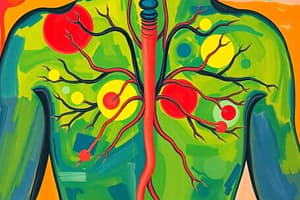Podcast
Questions and Answers
What is the primary effect of adrenergic antagonists?
What is the primary effect of adrenergic antagonists?
- They directly stimulate the sympathetic nervous system.
- They prevent activation of adrenergic receptors. (correct)
- They increase the release of catecholamines from the adrenal medulla.
- They increase the activation of adrenergic receptors.
Which type of adrenergic antagonist is known for its selective action on Beta-1 receptors?
Which type of adrenergic antagonist is known for its selective action on Beta-1 receptors?
- Esmolol (correct)
- Carvedilol
- Labetalol
- Propranolol
What characterizes cholinergic medications in their action on neurotransmitters?
What characterizes cholinergic medications in their action on neurotransmitters?
- They directly inhibit acetylcholinesterase.
- They block muscarinic receptors.
- They stimulate the parasympathetic nervous system. (correct)
- They prevent the release of acetylcholine.
Which of the following signs is NOT associated with a cholinergic crisis?
Which of the following signs is NOT associated with a cholinergic crisis?
What effect is associated with blockers of acetylcholinesterase?
What effect is associated with blockers of acetylcholinesterase?
Which neurotransmitter is primarily associated with the sympathetic nervous system's activation?
Which neurotransmitter is primarily associated with the sympathetic nervous system's activation?
What allows alpha-adrenergic blocking agents to specifically target blood pressure regulation?
What allows alpha-adrenergic blocking agents to specifically target blood pressure regulation?
What are the characteristics of a nonselective beta-blocker?
What are the characteristics of a nonselective beta-blocker?
Which of the following best describes the role of the adrenal medulla in autonomic regulation?
Which of the following best describes the role of the adrenal medulla in autonomic regulation?
Which characteristic best describes the sympathetic nervous system's nerve distribution?
Which characteristic best describes the sympathetic nervous system's nerve distribution?
What distinguishes parasympathetic postganglionic nerve fibers from sympathetic postganglionic nerve fibers?
What distinguishes parasympathetic postganglionic nerve fibers from sympathetic postganglionic nerve fibers?
What neurotransmitter is primarily involved in the sympathetic nervous system?
What neurotransmitter is primarily involved in the sympathetic nervous system?
What occurs when the alpha receptors in the autonomic nervous system are activated?
What occurs when the alpha receptors in the autonomic nervous system are activated?
Which of the following best describes the adrenal medulla's role in the autonomic nervous system?
Which of the following best describes the adrenal medulla's role in the autonomic nervous system?
In which way do adrenergic and cholinergic receptors differ in the context of the autonomic nervous system?
In which way do adrenergic and cholinergic receptors differ in the context of the autonomic nervous system?
Which statement about the two-neuron system of the autonomic nervous system is correct?
Which statement about the two-neuron system of the autonomic nervous system is correct?
What physiological function is affected by the activation of beta-2 adrenergic receptors?
What physiological function is affected by the activation of beta-2 adrenergic receptors?
In blood pressure control, which receptors play a crucial role during sympathetic activation?
In blood pressure control, which receptors play a crucial role during sympathetic activation?
What is the primary neurotransmitter released at the neuromuscular junction that facilitates muscle contraction?
What is the primary neurotransmitter released at the neuromuscular junction that facilitates muscle contraction?
How does the body terminate the action of norepinephrine quickly in the system?
How does the body terminate the action of norepinephrine quickly in the system?
Which receptor activation is primarily responsible for increased heart rate and contractility during stress?
Which receptor activation is primarily responsible for increased heart rate and contractility during stress?
What physiological impact is associated with the activation of muscarinic receptors in target organs?
What physiological impact is associated with the activation of muscarinic receptors in target organs?
What differentiates sympathetic nerve fibers from parasympathetic nerve fibers in terms of their connectivity to effector organs?
What differentiates sympathetic nerve fibers from parasympathetic nerve fibers in terms of their connectivity to effector organs?
What is primarily responsible for the rapid increase in heart rate during a sympathetic response?
What is primarily responsible for the rapid increase in heart rate during a sympathetic response?
Which statement accurately describes the balance between the sympathetic and parasympathetic nervous systems?
Which statement accurately describes the balance between the sympathetic and parasympathetic nervous systems?
What is the role of the nucleus tractus solitarius within the autonomic nervous system?
What is the role of the nucleus tractus solitarius within the autonomic nervous system?
Which neurotransmitter is primarily responsible for increasing sweating under sympathetic stimulation?
Which neurotransmitter is primarily responsible for increasing sweating under sympathetic stimulation?
What is a primary effect of the adrenal medulla during a sympathetic response?
What is a primary effect of the adrenal medulla during a sympathetic response?
What physiological action is primarily regulated by the parasympathetic nervous system?
What physiological action is primarily regulated by the parasympathetic nervous system?
How does the body typically respond to increased blood pressure as detected by baroreceptors?
How does the body typically respond to increased blood pressure as detected by baroreceptors?
Which of the following conditions indicates a sympathetic nervous system overactivity?
Which of the following conditions indicates a sympathetic nervous system overactivity?
What mechanism helps maintain blood pressure during trauma according to the autonomic nervous system?
What mechanism helps maintain blood pressure during trauma according to the autonomic nervous system?
Which cranial nerve is MOST responsible for the majority of parasympathetic activity?
Which cranial nerve is MOST responsible for the majority of parasympathetic activity?
What is a possible long-term consequence of a denervation injury?
What is a possible long-term consequence of a denervation injury?
Which drug type mimics the effects of catecholamines in the sympathetic nervous system?
Which drug type mimics the effects of catecholamines in the sympathetic nervous system?
Which system controls bowel motility primarily?
Which system controls bowel motility primarily?
Which circumstance may lead to a hypotensive state immediately following spinal anesthesia?
Which circumstance may lead to a hypotensive state immediately following spinal anesthesia?
Flashcards are hidden until you start studying
Study Notes
Sympathetic and Parasympathetic Nerve Distribution
- Sympathetic nerves originate from the thoracolumbar region, demonstrating close proximity to effectors and diffuse innervation.
- Parasympathetic nerves arise from the craniosacral region, with some synapsing early and others reaching target organs, leading to a more focused and discrete response.
Cervical Ganglia
- Comprise superior, medial, and inferior ganglia; inferior cervical ganglion often fuses with the 1st thoracic ganglion to form the stellate ganglion, impacting sensory functions like smell recovery.
- Stellate ganglion blocks are utilized for various conditions including chronic pain and PTSD.
Autonomic Nervous System (ANS) Structure
- The ANS, encompassing both sympathetic (SNS) and parasympathetic (PSNS) components, includes a two-neuron system (preganglionic and postganglionic fibers).
- Preganglionic fibers are myelinated and use acetylcholine (ACh), while postganglionic fibers are unmyelinated, slower, and utilize norepinephrine (SNS) or ACh (PSNS).
Neurotransmitter Roles
- ACh is the neurotransmitter for all preganglionic fibers and most parasympathetic postganglionic fibers; norepinephrine predominantly functions in sympathetic postganglionic signaling.
- Cholinergic receptors (muscarinic and nicotinic) respond to ACh across various tissues, while adrenergic receptors are activated by norepinephrine and epinephrine, influencing a range of physiological responses.
Receptor Types and Effects
- Muscarinic receptors: Found on effector cells affected by cholinergic neurons; play a role in bodily functions regulated by the PSNS and SNS.
- Nicotinic receptors: Exist at autonomic ganglia and neuromuscular junctions, mediating fast synaptic transmission.
- Adrenergic receptors: Divided into alpha and beta types, influencing vasoconstriction, heart rate, and bronchodilation through norepinephrine and epinephrine.
Pharmacological Mechanisms
- Cholinergic medications enhance PSNS activity via direct receptor activation or inhibition of ACh breakdown.
- Adrenergic antagonists are used for treating hypertension and other conditions, with effects dependent on receptor types targeted.
Cholinergic Crisis and Treatment
- Characterized by excessive muscarinic stimulation leading to symptoms like salivation and bradycardia; treatment typically includes anticholinergics like atropine.
Homeostasis and ANS Functionality
- The ANS maintains homeostasis by balancing SNS and PSNS activity, regulating blood pressure, gastrointestinal motility, and temperature—typically activated rapidly by neural centers in the spinal cord and brainstem.
Autonomic Dysregulation
- Autonomic dysreflexia is a condition post-spinal cord injury that leads to uncontrolled sympathetic responses, often after stimuli below the injury site, posing severe risks of hypertension and other complications.
Synthesis and Metabolism of Neurotransmitters
- ACh is synthesized from choline and acetyl-CoA, with breakdown via acetylcholinesterase; norepinephrine is formed in adrenergic fibers, with metabolism occurring through MAO and COMT pathways.
Effects of the Adrenal Medulla
- The adrenal medulla releases epinephrine and norepinephrine in response to sympathetic stimulation, providing prolonged action (5-10x) through dual mechanisms of SNS stimulation.
Intrinsic Personality Change Post-Injury
- Following denervation injuries, there is increased intrinsic tone in smooth muscle of vessels and heightened sensitivity to catecholamines, demonstrating adaptive physiological changes over time.
Key Points on Autonomic Pharmacology
- Drug classifications include sympathomimetics (increase SNS), cholinomimetics (increase PSNS), and respective antagonists that decrease activity of these systems, influencing various clinical outcomes depending on specific receptor interactions.
Studying That Suits You
Use AI to generate personalized quizzes and flashcards to suit your learning preferences.





